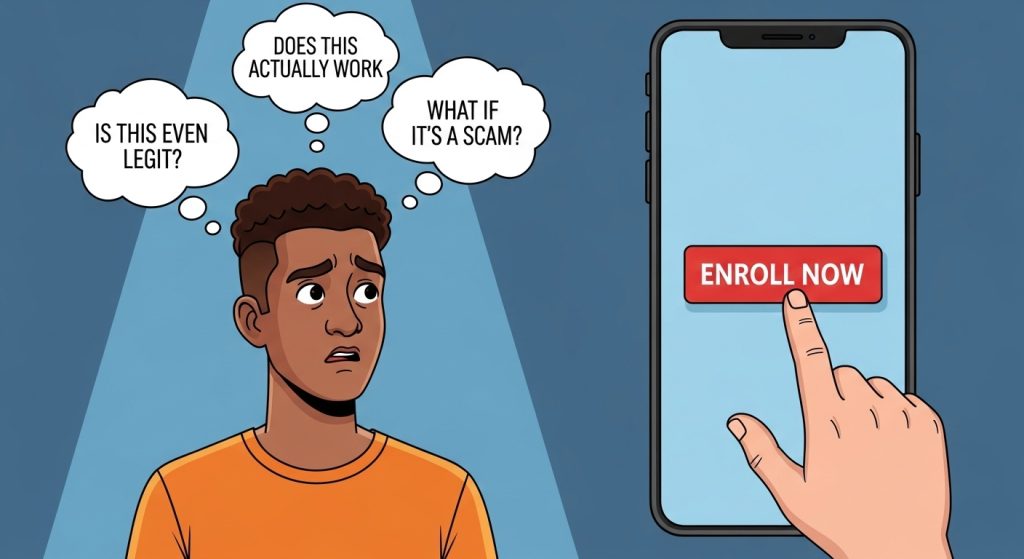It’s frustrating to know how much value you deliver with your course, yet people aren’t buying. You pour your heart, time, and expertise into creating an incredible course. The content is solid. The transformation is real. You’ve done everything right or so it seems. But when the time comes to convert curious visitors into paying students, all you get are leads that lead nowhere.
It is easy to think that there is a problem with your pricing, that you are probably overpriced. But price is scarcely the problem. People pay thousands of dollars for mentorship, courses and coaching sessions. Neither is it in your curriculum. People who offer less have students filling up their classes every cohort.
If you’ve been in this space long enough, you’ll know this is a common frustration for digital creators, coaches, and training companies. And while it’s easy to blame the price, timing, or algorithm, the real culprit is often simpler and sneakier: a lack of trust.
People don’t buy what they don’t trust. We are in the age of online courses and virtual learning, where scams, half-baked promises, and underwhelming experiences are all too common. So, it is not a surprise that potential students hesitate. They need more than your word or a polished pitch to believe your course will work for them. They need proof, and that’s exactly where reviews come in.
People want to buy your course. They want the transformation you’re promising. But without proof that it works, their doubts win. They have questions that only real reviews can answer. Questions like:
- “What if it’s not worth it?”
- “What if I can’t keep up?”
- “What if this is just another overhyped program?”
In this post, we’ll unpack how reviews calm buyer nerves, inspire confidence, and can be the difference between a bounce and a sale. If you’re tired of second-guessing your sales page, you’ll want to keep reading.
The real reason they’re not buying
When someone clicks on your course post or ad, they scroll through your beautifully written sales page, nod along to your promises, hover over the “Enroll Now” button, and then, they quietly close the tab.
What just happened?
This is the silent dropout moment many course creators never see, but it happens all the time. And it’s not because your course isn’t good enough or because the ad copy wasn’t persuasive enough. It is simply because your potential customer hit a wall called buyer hesitation.
Buyer hesitation is that space between curiosity and commitment where doubt creeps in:
- “What if I pay for this course and it doesn’t work for me?”
- “Has anyone like me actually gotten results from this?”
- “Can I trust this creator, or is this just good marketing?”
- “Will I even finish the course?”
These thoughts don’t usually get voiced out loud. But they’re loud in the head of your potential student. Unless something shifts that mindset in real-time, they would hesitate. The result is that they walk away, not because they don’t want what you’re offering, but because they aren’t sure it will deliver for them.
Your courses are digital products. Unlike buying a pair of shoes or a phone, your audience can’t see, touch, or “test-drive” your course. They’re making an investment based entirely on trust. If that trust is not there, it doesn’t matter how good your offer is; they’ll pass.
You may have tried to overcome hesitation by doubling down on features. You include things like:
- “You get 30+ video lessons…”
- “Downloadable worksheets…”
- “Lifetime access!”
All of that is great, but it doesn’t answer the core question of your potential student: “Will this work for me?”
The answers to these questions lie in the reviews you, are yet to collect. When potential students see real people just like them sharing how your course helped them achieve results, their hesitation starts to melt away. They’re no longer relying on your pitch alone. They’re seeing proof. That proof is what turns a curious browser into a confident student.
How Reviews Break Buyer Hesitation
Reviews are one of the most persuasive tools you can use to build trust and drive course sales. Why? They speak directly to the buyer’s inner doubts.
When someone sees that others have already enrolled in your course, gone through the process, and gotten real results, it sends a powerful subconscious message: “This works. You’re not the first. You can do this too.”
Let’s break down what reviews actually do in the mind of a potential student:
1. They provide social proof: We’re wired to look for validation in uncertain situations. If 10 people are raving about a course, we instinctively feel safer buying it. Reviews show that others have gone before us and they didn’t regret it.
2. They answer the unspoken questions: A good review can answer the questions your sales page can’t:
- “Was this course easy to follow?”
- “Did it actually help someone land clients?”
- “Is it worth the investment?”
When people see someone just like them succeed, it’s no longer just a possibility; it becomes a believable outcome.
3. They humanize your offer: A sales page tells. A review shows. And what it shows is the human impact of your work. That transformation isn’t just a promise, it’s a personal story. That emotional connection builds confidence faster than any bullet point ever will.
4. They reduce perceived risk: Digital purchases come with a layer of uncertainty, especially if the buyer doesn’t know you personally. Reviews act like mini-referrals from strangers. The more positive feedback you display, the less risky your course feels.
5. They Build Momentum: When buyers see that others are already inside your course, actively learning and winning, it triggers a bit of healthy FOMO (Fear of Missing Out). Reviews tap into that psychology and turn passive readers into motivated buyers.
In short, reviews do what your landing page alone can’t: They build credibility, calm fears, and inspire action.
How to start collecting and displaying reviews today
You don’t need thousands of students or a fancy system to start using reviews effectively. What you do need is intentionality. Whether you’ve had 5 students or 50, you can begin gathering social proof right now. Here’s how:
Step 1: Ask at the right time
The best time to request a review is right after your student has had a win, whether they just finished a module, landed a client, gained clarity, or experienced a breakthrough. Catch them when they’re still excited and grateful. For this, you could automate an email or message to go out a few days after course completion or after key milestones.
Step 2: Make it easy to respond
Don’t just say, “Can you leave a review?” Most people freeze at that. Instead, guide them. Provide simple prompts like:
- “What was your biggest takeaway from this course?”
- “How has your life or business changed since you joined?”
- “What would you tell someone thinking about joining?”
To make this super easy, you can get registered on Parrot for free, and simply send their personalized link to your students to leave a review for you.
Step 3: Collect a variety of formats
Different formats speak to different types of buyers:
- Text testimonials work well on landing pages.
- Video reviews feel more authentic and build stronger emotional connections.
- Screenshots of chats or DMs (with permission) add raw, real-time proof.
- Before/after stories give context and show transformation.
The more natural and relatable, the better.
Step 4: Put reviews where they matter most
Gathering reviews is just the beginning. The next step is your placement. Placement is everything. People need to see the reviews to believe them.
- Add them strategically across your sales page, especially near your Call-To-Action buttons.
- Include them in email campaigns, checkout pages, and even Instagram stories.
- Don’t be afraid to repurpose reviews into content. You can have them as ‘Student Spotlight’ posts, reels, or quote graphics.
Step 5: Keep it fresh
Outdated reviews make your offer feel stagnant. Make it a habit to ask for new testimonials regularly. The more recent and specific, the more powerful they are.
Bonus Tip: Celebrate your students publicly. Tag them when you share their success stories. This not only builds trust with future buyers, but strengthens your relationship with current ones.
Social proof doesn’t require a massive following. It just requires real results, shared honestly. You can start simple, and you should start now.
Conclusion
The digital space is now very crowded and trust can only be built through real voices, real stories, and real results.
If your course isn’t selling the way it should, it’s likely not because it lacks value but because potential students don’t have enough proof that it delivers. That’s where real reviews from real people change everything.
By sharing authentic feedback from the students you’ve already trained, you show others what’s possible. You dissolve hesitation. You make the transformation feel real.
And the best part? You don’t have to figure out how to do it on your own.
With Parrot, our convenient, powerful customer review and customer intelligence app built for creators and coaches, you can start collecting student reviews without stress. Just send your students your Parrot link, and they can drop quick, honest reviews that go straight to your dashboard, ready to be used on your landing pages, emails, and social media.
Don’t let silent doubts keep your dream students from enrolling. Start using Parrot to collect and share the kind of reviews that build trust and boost sales.
Sign up on Parrot for FREE now.

Mayowa Oluwashanu
Content Writer



